 Photo: Venerala / Adobe Stock
Photo: Venerala / Adobe Stock
When it comes to fiber cement siding versus vinyl, the biggest differences relate to their costs, aesthetics, and upkeep. Vinyl might be an affordable, low-maintenance option, but it doesn’t have the natural appearance of fiber cement (sometimes known as Hardie board). Breaking down the distinctive attributes of Hardie board versus vinyl siding will help you decide which of these popular siding types is best to protect your home’s exterior.
In this article:
- What Is Fiber Cement Siding?
- What Is Vinyl Siding?
- Appearance
- Cost
- Upkeep
- Durability
- Installation
- Life Span
- Environmental Impact
- Is Fiber Cement Siding or Vinyl Siding Better for Your Home?
- Fiber Cement and Vinyl Siding vs. Other Options
What Is Fiber Cement Siding?
Fiber cement is a synthetic siding made by mixing Portland cement, sand, water, and cellulose fiber. Wood pulp is sometimes included as well as other ingredients, depending on the manufacturer. This semi-rigid material is durable while offering a degree of flexibility and a wood-like appearance. It’s typically formed into long boards or shingles.
You might hear it referred to as Hardie board siding or HardiePlank. This relates to the most popular fiber cement siding produced by manufacturer James Hardie.
What Is Vinyl Siding?
Vinyl siding is typically made from PVC, a polymer of vinyl chloride. In the last couple of decades, it has become the most popular of all the siding options in the U.S.—and for good reason. This versatile, rigid synthetic plastic siding is durable, low maintenance, and affordable. Unsurprisingly, other vinyl building products, like flooring and fencing, are also popular.
Appearance
Whether you opt for vinyl siding versus Hardiplank depends on if you’re aiming for an authentic, elegant design or if you want different decorative elements for a modern facade.
| Fiber Cement Siding | Vinyl Siding |
|---|---|
| More natural look | Manufactured look |
| Easy to paint | Not easy to stain or paint |
| Available in pre-painted designs | Huge range of colors and designs available |
Fiber Cement Siding
Fiber cement is the way to go if you want to replicate a wood siding appearance with a more durable material. Its available textures better replicate real wood, cedar shake, or stone than vinyl siding. It also comes in a wide range of pre-painted colors and shapes.
If your fiber cement siding is still in good condition after a decade, you can easily stain or paint it to give your home’s exterior a makeover.
Vinyl Siding
Vinyl siding has the most comprehensive range of decorative styles, colors, and shapes. However, while this siding has finishes replicating faux-wood grain, they don’t have the elegant, authentic nature of fiber cement or real wood. Plus, you’ll need to choose your color carefully, as you can’t easily paint over it.
Dirt and debris cling to the plastic finish, making the home’s exterior look untidy more quickly.
Ready to Start Your Siding Installation?Cost
Vinyl invariably comes out a little on top in terms of cost to install siding, but it might need replacing sooner than fiber cement. But both options are affordable and long-lasting.
| Fiber Cement Siding | Vinyl Siding |
|---|---|
| $5 – $14 per sq. ft. | $3 – $12 per sq. ft. |
Fiber Cement Siding
Typically, fiber cement siding costs between $5 and $14 per square foot. The upfront material and installation costs might be more, but with the proper maintenance, fiber cement continues to look in good condition for longer than vinyl siding.
Vinyl Siding
Vinyl siding costs from $3 to $12 per square foot to purchase and install. While this affordable option won’t need repainting or re-caulking, keep in mind that it might need replacing before well-maintained fiber cement siding.
Upkeep
When it comes to siding maintenance, vinyl siding might be the best option if you’re not a fan of regular work.
| Fiber Cement Siding | Vinyl Siding |
|---|---|
| Needs annual scrubbing down | Virtually maintenance-free |
| Periodic re-caulking is a possibility | Simply hose down to clean |
| Requires repainting every decade or so | More economical to repair |
Fiber Cement Siding
While it isn’t as high-maintenance as wood siding, fiber cement siding still needs more maintenance than vinyl. To keep it looking tidy and to extend its longevity, it needs a scrub down to clean at least annually and repainted every decade or so when fading becomes noticeable. It may also need periodic re-caulking to prevent water ingress.
Typical costs to repair fiber cement siding work out between $4 and $7 per square foot, but luckily, it’s a hard-wearing material.
Vinyl Siding
One of the biggest selling points of vinyl is how low maintenance it is. You won’t need to repaint or do any additional caulking work after installation, and even cleaning is a simple task. Going over it with a garden hose or low-pressure power washer is usually enough for it to come up fresh.
Repairs on entire vinyl siding panels can be more complex and costly than replacing one or two fiber cement shingles or boards. But generally, the cost to repair siding made of vinyl is economical, working out between $2 and $4 per square foot.
Durability
Both fiber cement siding and vinyl are more tough and long-lasting options compared to wood. But fiber cement probably pips vinyl at the post in terms of durability.
| Fiber Cement Siding | Vinyl Siding |
|---|---|
| Mold- and insect-resistant | Rot- and insect-resistant |
| Fire-retardant | Discolors under strong UV rays |
| Can handle wide temperature fluctuations | Becomes brittle in freezing temperatures |
| Can absorb moisture | Susceptible to storm damage |
Fiber Cement Siding
Dense, fire-retardant fiber cement siding often comes with a lifetime guarantee. It’s mold- and insect-resistant and often used on homes in regions that experience extreme weather. It holds up without warping in harsh storms and where the temperatures fluctuate widely.
But to maintain its durability, it needs to be well-maintained. If the caulking is no longer providing an effective seal or there are installation issues, the fiber cement absorbs moisture. This results in reduced longevity and potential structural damage to your home.
Vinyl Siding
Vinyl siding is also robust. It’s rot- and insect-resistant, flexible, and won’t warp under the scorching sun, although it can discolor because of strong UV rays. Vinyl siding isn’t the best choice for regions that experience frigid winters. It loses its flexibility when it freezes and becomes more prone to cracking on impact. Plus, storm wind debris can mark your vinyl.
Installation
It’s best to hire a local siding contractor to fit fiber cement or vinyl siding. However, lightweight vinyl makes a better DIY installation project if you have construction and siding knowledge. Just note that all siding can have major issues if you don’t install it correctly.
| Fiber Cement Siding | Vinyl Siding |
|---|---|
| Professional installation is a must | DIY is possible with the right experience |
| Heavy and difficult to handle | Lightweight |
| Cutting fiber cement can release harmful dust | Doesn’t require caulking or painting |
Fiber Cement Siding
Installing fiber cement siding isn’t a DIY job. It’s a heavy material weighing approximately 150 pounds for every 50 square feet, and its rigid construction means it can easily break if you mishandle it. Plus, crystalline silica is usually present in fiber cement siding. If you don’t take appropriate safety measures when cutting the siding, this can lead to inhaling hazardous dust.
Vinyl Siding
Vinyl is one of the easiest siding options to install. It’s lightweight, coming in at approximately 30 to 35 pounds per square foot, and there’s no caulking or painting required. But installing this siding poorly can lead to water ingress, cracking, or buckling.
Start Your Siding Installation TodayLife Span
You might never have to replace your fiber cement or vinyl siding if you keep up with maintenance. They both have great longevity.
| Fiber Cement Siding | Vinyl Siding |
|---|---|
| Up to 50 years | Up to 30 years |
Fiber Cement Siding
Fiber cement siding typically comes with 30- to 50-year warranties because it’s so durable. However, this longevity depends on proper installation and the right maintenance, such as painting and regular re-caulking.
Vinyl Siding
With little maintenance, it’s not unusual for vinyl siding to last up to 30 years. Warranties of up to 25 years are common. However, it can start to discolor and show signs of wear after a decade.
Environmental Impact
While wood is a more environmentally friendly siding option, if you’re deciding between Hardie board versus vinyl siding, then opting for fiber cement makes sense.
| Fiber Cement Siding | Vinyl Siding |
|---|---|
| Sustainable and biodegradable material | Some vinyl siding is recyclable |
| Not recyclable | Manufacturing can release toxic chemicals |
| Not energy-efficient | Insulated vinyl siding is more energy-efficient |
| Doesn’t need replacing as frequently |
Fiber Cement Siding
Fiber cement is a more sustainable material than vinyl, and its natural composition breaks down more readily after use. It doesn’t require the use of fossil fuels for its production and doesn’t emit hazardous gasses. However, it isn’t possible to recycle fiber cement, and because it’s a poor insulator, it’s not particularly energy-efficient.
Vinyl Siding
It’s possible to find recycled vinyl siding, but when it does eventually need disposing, it often ends up in a landfill where it won’t break down well.
The vinyl siding manufacturing process uses a lot of fossil fuels and, unfortunately, can release toxic chemicals into the environment when burning in a landfill. Some processing plants are more ethical than others, so it pays to do your research. In addition, vinyl siding comes in insulated varieties, offering more energy efficiency than fiber cement siding.
Is Fiber Cement Siding or Vinyl Siding Better for Your Home?
Whether vinyl siding or cement board is the right choice for your home’s exterior depends on your budget, the desired look, and how much maintenance you are happy to undertake.
| Factors | Fiber Cement Siding | Vinyl Siding |
|---|---|---|
| Appearance | More natural look | Manufactured look |
| Cost | $5 – $14 per sq. ft. | $3 – $12 per sq. ft. |
| Upkeep | Needs more maintenance | Low-maintenance |
| Durability | Mold-, insect-. and fire-resistant | Robust but brittle in freezes |
| Installation | Leave to the pros | Possible for experienced DIY-ers to install |
| Life Span | Up 50 years | Up to 30 years |
| Environmental Impact | More environmentally friendly | Releases harmful gasses |
Fiber Cement and Vinyl Siding vs. Other Options
It’s not just vinyl siding or HardiePlank you have to choose from. Here are some other widely used siding materials worth considering, with their own pros and cons.
Wood Siding
Traditional and timeless wood siding remains a popular option. Durability, look, and cost varies depending on the type of wood you select. Affordable wood siding costs between $3 and $10 per square foot, and while it isn’t as durable as fiber cement or vinyl siding, it’s an eco-friendly and attractive choice.
Stucco Siding
Stucco siding costs from $6.50 to $10 per square foot. This affordable and sustainable material is durable and unique. However, stucco siding needs professional installation, and it’s prone to water retention and cracking.
Stone Veneer Siding
Stone veneer siding costs between $35 and $50 per square foot. This pricey material is made from Portland cement, iron oxides, and aggregates that mimic heavier and more expensive real stone. It’s durable and low-maintenance, but water ingress can become a significant problem with stone veneer siding without proper installation.
Still Have Questions About Siding Installation?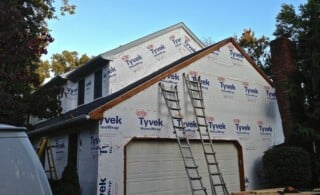 Siding Replacement: What to Expect
Siding Replacement: What to Expect 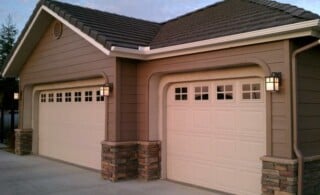 Masonite Siding: A Strong Alternative
Masonite Siding: A Strong Alternative 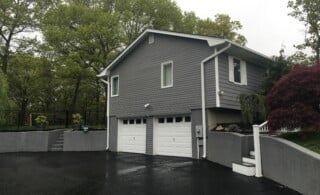 Liquid Siding – Worth a Look?
Liquid Siding – Worth a Look? 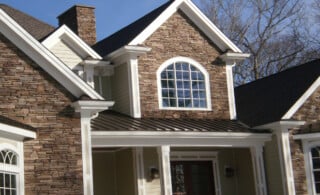 Stone Veneer: Better than the Real Thing?
Stone Veneer: Better than the Real Thing? 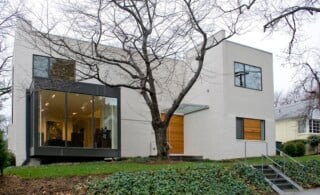 6 Environmentally Friendly Siding Materials
6 Environmentally Friendly Siding Materials 

Have replaced my 30 year old vinyl with hardiplank. Did it all by myself on a 2 story house. It 4 years old now and looks great. Like in SC and the vinyl was noisy from expansion. I am sold on Hardiplank. Only vinyl is on the sofit.
This article is full of inaccuracies and mistakes on the details concerning vinyl siding.
Hi Chuck,
I’m sorry that you’re reading inaccuracies. We’re happy to make revisions based on your knowledge of vinyl siding for the benefit of readers. Let us know what’s wrong.
Thank you!
Implying that Vinyl Siding can be “re-painted” is ridiculous. Re-paint Hardie Planks every 5-10 years is inaccurate.
If one uses the PROPER primer – and primes the edges before installing – Caulk joints and use a top quality paint – like PP Timeless (Timeless has some poly in it – painters don’t like it because it is sticky and hard to clean) you don’t have to paint every 5-10 years. I have gone over 20 years – at least on west – full sun – facing walls in Kansas – shaded walls might go twice that. Cheap paint is expensive in the long run – the labor of painting is expensive.
Vinyl can also have problems with creep – thermal expansion – so it looks like a balloon on hot days – most installers don’t know how to compensate – installing vinyl CORRECTLY is not so easy.
We had vinyl siding on an upper part of the house near the roof with metal flashing. It became very warped and discolored and allowed water leakage. Vinyl also requires J trims when siding around object or protrusions. This is very time consuming and unattractive also when you have to screw something onto a wall that has vinyl it can no longer expand and contract as it needs thus it becomes disfigured. Vinyl corners have a hollow area and edges are easily broken when hit and can be difficult to repair not to mention an area for rodents or insects to access. In all these situations Cement fiber is far superior. I do like the simplicity and cost of vinyl siding and usually use both products together to get the best of both.
We live up in Calgary Canada. Our winters regularly hit -30 degrees Celcius and our summers can hit 35 degrees Celcius. We also have some terrific prairie hail storms that absolutely decimate vinyl siding. We move around our house in the winter cold snaps with caution; extremely cold vinyl siding on the corners of our house and near our driveway have shattered when struck by one of our idiot dogs or even a shovelful of snow! We hear almost everything that’s going on on our street, despite house wrap and triple-paned windows, so NO, vinyl siding isn’t the one to go with in cold climates. Our new HardieBoard siding has provided sound insulation, looks awesome and has survived two idiot chocolate labs and their rambunctiousness, not to mention two very busy grandsons and their hockey sticks! Up here Cement Board siding is about $12,000 more expensive to install than vinyl but WAY more worth it.